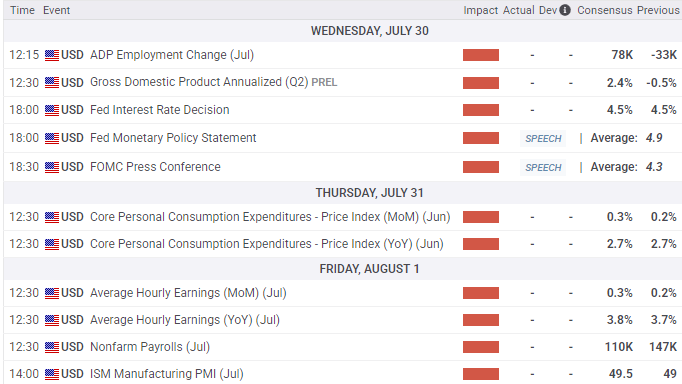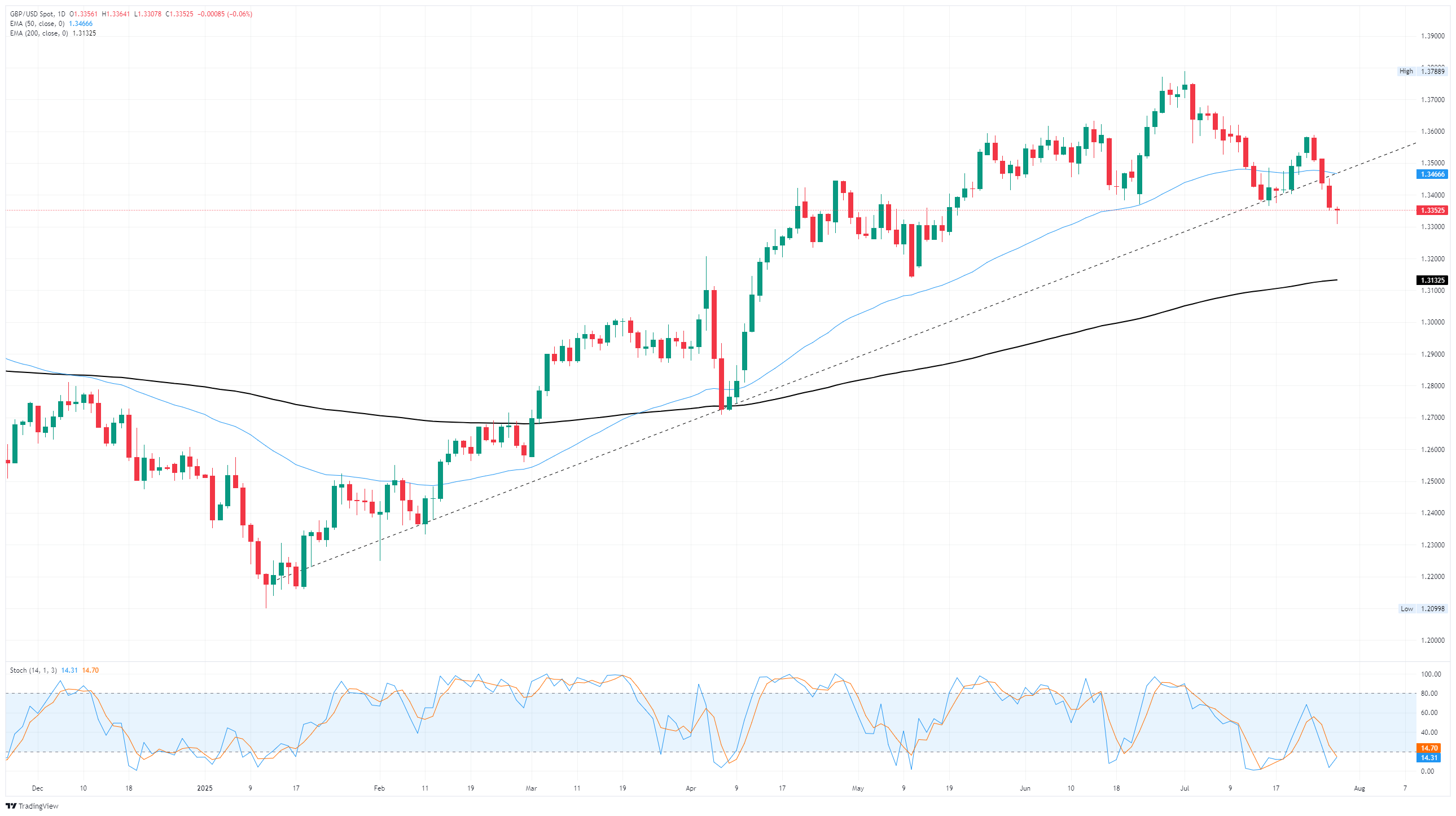GBP/USD finds bottom ahead of key Fed rate call
- GBP/USD rebounded on Tuesday, trimming losses after a technical bounce near 1.3300.
- A lack of UK data leaves US releases at the top of the pile.
- US GDP, PCE inflation, and NFP jobs reports will make for a heavy week.
GBP/USD found some balance on Tuesday, pumping the brakes on an extended backslide but falling just short of snapping its losing streak. The Cable pair caught an intraday technical rebound near the 1.3300 handle, and FX markets are coiling ahead of the Federal Reserve’s (Fed) latest interest rate decision, due on Wednesday.
There remains little of note on the economic calendar for the United Kingdom (UK) side, leaving Cable traders to grapple with a hefty dose of US data releases through the remainder of the trading week.
The Fed’s latest interest rate decision is slated for Wednesday and is expected to draw plenty of investor attention. The US central bank is broadly expected to keep interest rates on hold in the 4.25-4.5% range this week, but traders will be looking for signs that the Fed is still on track to deliver a fresh quarter-point rate trim at its next meeting on September 17.
Triple-threat US data docket on the radar this week
Besides an interest rate call from the most powerful central bank in the world, investors will also be contending with a US GDP update early Wednesday. Quarterly US GDP growth last clocked in at a disappointing -0.5% in Q1, and markets are hoping for a sharp recovery to 2.4% in annualized growth in Q2.
US PCE inflation, due on Thursday, is expected to accelerate slightly, with analysts anticipating an uptick to 0.3% MoM in June compared to the previous month’s 0.2%. A resurgence of inflationary pressure is the last thing investors want, as it could spell doom for ongoing rate cut expectations.
Friday’s NFP jobs report could add further fuel to rate hold fears. July’s NFP net employment gains report is expected to hold in positive territory after seasonal adjustments. However, the figure is expected to ease to 110K from June’s 147K.

GBP/USD price forecast
Tuesday’s mid-day turnaround in Cable bidding could mark the end of the pair’s near-term losing streak. 1.3300 has been marked in as an interim technical support level, and GBP/USD bidders will be looking to claw back territory north of the 50-day Exponential Moving Average (EMA) and the 1.3500 major price handle.
GBP/USD daily chart

Pound Sterling FAQs
The Pound Sterling (GBP) is the oldest currency in the world (886 AD) and the official currency of the United Kingdom. It is the fourth most traded unit for foreign exchange (FX) in the world, accounting for 12% of all transactions, averaging $630 billion a day, according to 2022 data. Its key trading pairs are GBP/USD, also known as ‘Cable’, which accounts for 11% of FX, GBP/JPY, or the ‘Dragon’ as it is known by traders (3%), and EUR/GBP (2%). The Pound Sterling is issued by the Bank of England (BoE).
The single most important factor influencing the value of the Pound Sterling is monetary policy decided by the Bank of England. The BoE bases its decisions on whether it has achieved its primary goal of “price stability” – a steady inflation rate of around 2%. Its primary tool for achieving this is the adjustment of interest rates. When inflation is too high, the BoE will try to rein it in by raising interest rates, making it more expensive for people and businesses to access credit. This is generally positive for GBP, as higher interest rates make the UK a more attractive place for global investors to park their money. When inflation falls too low it is a sign economic growth is slowing. In this scenario, the BoE will consider lowering interest rates to cheapen credit so businesses will borrow more to invest in growth-generating projects.
Data releases gauge the health of the economy and can impact the value of the Pound Sterling. Indicators such as GDP, Manufacturing and Services PMIs, and employment can all influence the direction of the GBP. A strong economy is good for Sterling. Not only does it attract more foreign investment but it may encourage the BoE to put up interest rates, which will directly strengthen GBP. Otherwise, if economic data is weak, the Pound Sterling is likely to fall.
Another significant data release for the Pound Sterling is the Trade Balance. This indicator measures the difference between what a country earns from its exports and what it spends on imports over a given period. If a country produces highly sought-after exports, its currency will benefit purely from the extra demand created from foreign buyers seeking to purchase these goods. Therefore, a positive net Trade Balance strengthens a currency and vice versa for a negative balance.

